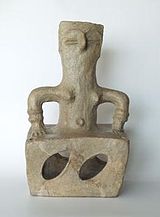

The European Neolithic is the period from the arrival of Neolithic (New Stone Age) technology and the associated population of Early European Farmers in Europe, c. 7000 BC (the approximate time of the first farming societies in Greece) until c. 2000–1700 BC (the beginning of Bronze Age Europe with the Nordic Bronze Age). The Neolithic overlaps the Mesolithic and Bronze Age periods in Europe as cultural changes moved from the southeast to northwest at about 1 km/year – this is called the Neolithic Expansion.[1]
The duration of the Neolithic varies from place to place, its end marked by the introduction of bronze tools: in southeast Europe it is approximately 4,000 years (i.e. 7000 BC–3000 BC) while in parts of Northwest Europe it is just under 3,000 years (c. 4500 BC–1700 BC). In parts of Europe, notably the Balkans, the period after c. 5000 BC is known as the Chalcolithic (Copper Age) due to the invention of copper smelting and the prevalence of copper tools, weapons and other artifacts.
The spread of the Neolithic from the Pre-Pottery Neolithic in the Near East to Europe was first studied quantitatively in the 1970s, when a sufficient number of 14C age determinations for early Neolithic sites had become available.[2] Ammerman and Cavalli-Sforza discovered a linear relationship between the age of an Early Neolithic site and its distance from the conventional source in the Near East (Jericho), thus demonstrating that the Neolithic spread at an average speed of about 1 km/yr.[2] More recent studies confirm these results and yield a speed of 0.6–1.3 km/yr at a 95% confidence level.[2]
- ^ Ammerman & Cavalli-Sforza 1971.
- ^ a b c Original text published under Creative Commons license CC BY 4.0: Shukurov, Anvar; Sarson, Graeme R.; Gangal, Kavita (2014). "The Near-Eastern Roots of the Neolithic in South Asia". PLOS ONE. 9 (5): e95714. Bibcode:2014PLoSO...995714G. doi:10.1371/journal.pone.0095714. PMC 4012948. PMID 24806472.
 Material was copied from this source, which is available under a Creative Commons Attribution 4.0 International License
Material was copied from this source, which is available under a Creative Commons Attribution 4.0 International License